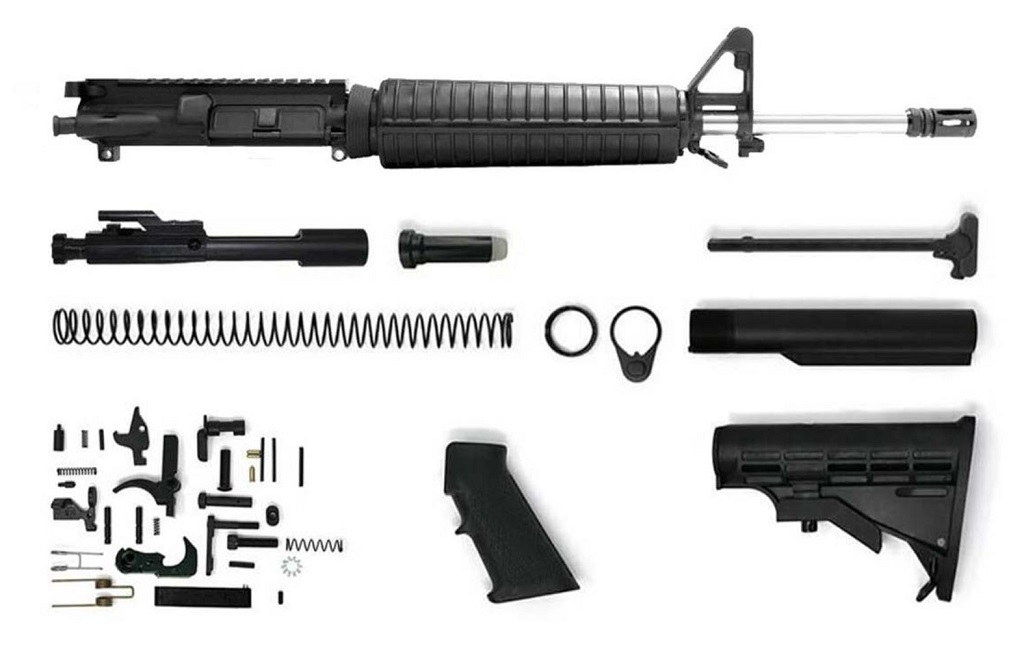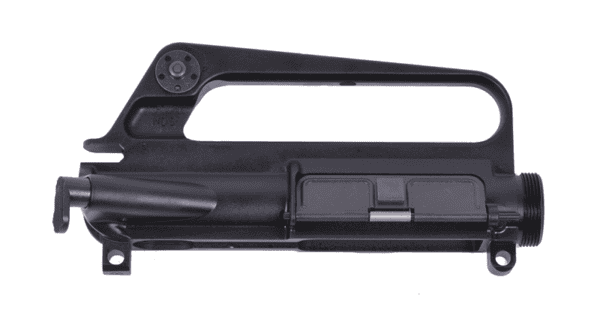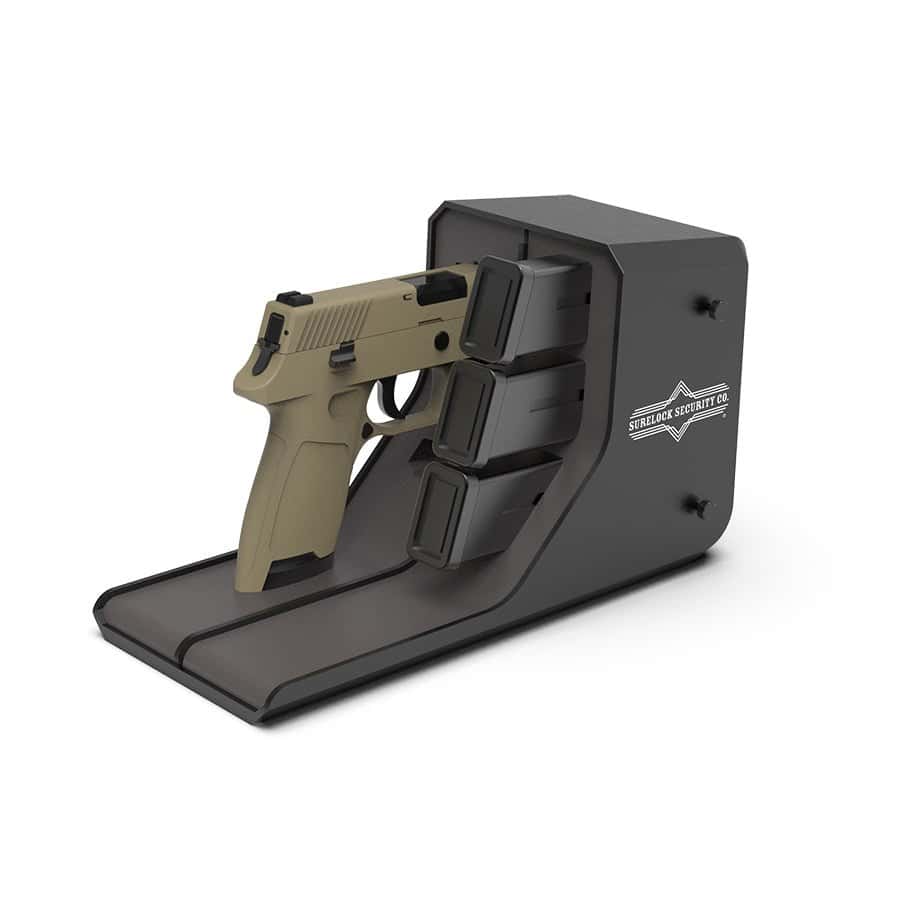Ar-15 uppers come in three main types: A1, A2, and A3/A4. Lowers typically are either forged, billet, or polymer.
The AR-15 is a versatile firearm, popular for its modularity and customization options. The upper receiver, responsible for housing the barrel and bolt carrier group, varies in design to fit different needs. The A1 upper offers basic features, the A2 introduces enhanced sights, and the A3/A4 is flat-topped for mounting optics.
The lower receiver, which houses the trigger group and magazine well, comes in forged, billet, and polymer forms. Forged lowers are durable and lightweight, billet lowers are precisely machined for custom builds, and polymer lowers are cost-effective and resistant to corrosion. Understanding these types helps in building a tailored AR-15.

Credit: www.gunbuilders.com
Introduction To Ar-15 Uppers And Lowers
The AR-15 is a popular rifle among firearm enthusiasts. It is known for its modularity. Understanding its key components is essential for customization. Let’s explore the different types of AR-15 uppers and lowers.
Brief History
The AR-15 was originally designed in the 1950s. It was created by Eugene Stoner. The rifle was first used by the U.S. military. Over time, it became popular among civilians. Its design allows for easy modifications. This is why many people love it.
Key Components
The AR-15 has two main parts: the upper and the lower. These parts can be swapped out for different styles.
| Component | Description |
|---|---|
| Upper Receiver | Holds the barrel, bolt carrier group, and charging handle. |
| Lower Receiver | Contains the trigger, magazine well, and stock. |
There are various types of upper and lower receivers:
- Stripped Uppers: Only the basic frame. No parts included.
- Complete Uppers: Includes all necessary parts.
- Stripped Lowers: Just the frame. No internal components.
- Complete Lowers: Comes with all internal parts installed.
Choosing the right components depends on your needs. This modularity makes the AR-15 versatile. Whether you want a lightweight build or a heavy-duty setup, you can customize it.

Credit: pro2a-tactical.com
Ar-15 Upper Receiver Types
The AR-15 upper receiver plays a crucial role in your rifle’s performance. It houses key components like the barrel, bolt carrier group, and charging handle. Knowing the different types of AR-15 uppers can help you make an informed choice.
Stripped Uppers
Stripped uppers are the basic, empty shell of the upper receiver. They come without additional parts like the forward assist or ejection port cover. You have the freedom to customize these parts according to your needs. Stripped uppers are great for those who prefer a DIY approach.
| Pros | Cons |
|---|---|
| Customizable | Requires assembly skills |
| Cost-effective | Time-consuming |
Complete Uppers
Complete uppers come pre-assembled with all the necessary components. They include the barrel, bolt carrier group, and charging handle. These are perfect for those who want a ready-to-use solution. Complete uppers save time and effort, offering a quick upgrade to your rifle.
| Pros | Cons |
|---|---|
| Ready to use | Less customizable |
| Time-saving | Higher initial cost |
A1, A2, A3, And A4 Uppers
The A1, A2, A3, and A4 uppers represent different generations of the AR-15. Each has unique features that cater to various needs.
- A1 Uppers: These are the earliest models with fixed carry handles and no forward assist.
- A2 Uppers: These have fixed carry handles and an integrated forward assist.
- A3 Uppers: These feature removable carry handles and flat-top rails for optics.
- A4 Uppers: These are similar to A3 but designed for more modern accessories.
Choosing the right upper receiver depends on your specific needs and preferences. Whether you prioritize customization or convenience, there’s an AR-15 upper receiver for you.
Material Choices For Uppers
Choosing the right material for your AR-15 upper is essential. Different materials offer unique benefits and drawbacks. Let’s explore the common options available.
Aluminum Alloys
Aluminum alloys are popular for AR-15 uppers. They are lightweight and durable. The most common types are 7075-T6 and 6061-T6.
| Alloy Type | Strength | Weight |
|---|---|---|
| 7075-T6 | High | Light |
| 6061-T6 | Medium | Light |
7075-T6 is stronger and preferred for combat rifles. 6061-T6 is more affordable and easier to machine.
Polymer Uppers
Polymer uppers are made from plastic materials. They are lightweight and corrosion-resistant. They are perfect for lightweight builds.
- Lightweight
- Corrosion-resistant
- Less expensive
Polymer uppers can be less durable than metal options. They might not handle heavy use well.
Steel Uppers
Steel uppers offer maximum durability. They are heavier but very strong. They are suitable for high-stress applications.
- Very strong
- Durable
- Heavier
Steel uppers are often used in precision rifles. They can handle high stress and heat.
Ar-15 Lower Receiver Types
The AR-15 rifle is famous for its modular design, allowing customization. The lower receiver is a critical part that houses the fire control group. Understanding the different types of AR-15 lower receivers is key to building or upgrading your rifle.
Stripped Lowers
Stripped lowers come as a bare frame without internal parts. They require assembly with a lower parts kit, including the trigger, hammer, and safety selector. This type offers flexibility for those who want a custom build. DIY enthusiasts prefer stripped lowers for hands-on experience.
Complete Lowers
Complete lowers are fully assembled units, ready to attach to an upper receiver. They include all internal parts and a stock. These are ideal for those who want a hassle-free setup. Complete lowers save time and ensure proper assembly by professionals.
80% Lowers
80% lowers are partially finished receivers, requiring additional machining. They do not qualify as firearms until completed, making them popular for hobbyists. Completing an 80% lower involves drilling and milling. This type offers ultimate customization and privacy.
Material Choices For Lowers
The lower receiver of an AR-15 is crucial. It affects durability, weight, and cost. Various materials are used for AR-15 lowers. Each has its benefits and drawbacks. This section explores the most common materials.
Aluminum Alloys
Aluminum alloys are a popular choice for AR-15 lowers. They provide a balance of strength and weight. The two most common grades are 6061-T6 and 7075-T6.
| Grade | Strength | Weight | Cost |
|---|---|---|---|
| 6061-T6 | High | Light | Lower |
| 7075-T6 | Very High | Very Light | Higher |
7075-T6 aluminum is stronger but more expensive. 6061-T6 is still robust and more affordable. Both are resistant to corrosion. They suit different budgets and needs.
Polymer Lowers
Polymer lowers are lightweight and cost-effective. They are made from high-strength plastic. These lowers are good for casual shooters and beginners.
- Lightweight
- Affordable
- Easy to work with
Polymer lowers can be less durable. They may not handle heavy use. They are great for low-cost builds. They are also easier to customize.
Billet Vs. Forged
AR-15 lowers can be billet or forged. Billet lowers are machined from a solid block of aluminum. Forged lowers are made by hammering aluminum into shape.
- Billet Lowers: Customizable, often more aesthetically pleasing.
- Forged Lowers: Stronger due to the forging process, usually cheaper.
Billet lowers offer more design options. Forged lowers are stronger and more affordable. Both are excellent choices based on preferences.
Customization Options
Customizing your AR-15 is an exciting journey. You can tailor it to fit your needs and style. From rail systems to barrel lengths and stock options, the choices are numerous. Let’s explore the various customization options available.
Rail Systems
The rail system is an important part of your AR-15. It holds accessories like optics, lights, and grips. Here are some popular rail systems:
- Picatinny Rail: Common and versatile. Easy to attach accessories.
- M-LOK Rail: Lightweight and sleek. Provides a modern look.
- KeyMod Rail: Known for its modularity. Offers a slim profile.
Barrel Lengths
Choosing the right barrel length affects accuracy and handling. Here are some options:
| Barrel Length | Benefits |
|---|---|
| 16 inches | Standard length. Balances accuracy and maneuverability. |
| 18 inches | Better accuracy at long range. Adds weight. |
| 20 inches | Optimal for long-range shooting. Less maneuverable. |
Stock Options
The stock affects comfort and control. Here are common stock options:
- Fixed Stock: Provides stability. No adjustment needed.
- Adjustable Stock: Offers flexibility. Fits different users.
- Folding Stock: Compact and portable. Ideal for storage.
With these customization options, you can create an AR-15 that fits your needs. Choose the right parts to enhance your shooting experience.
Legal Considerations
Understanding the legal considerations of AR-15 uppers and lowers is essential. Laws vary widely across states and at the federal level. Ensuring compliance can prevent legal troubles. This section covers state regulations, federal laws, and ownership requirements.
State Regulations
Different states have different laws about AR-15 uppers and lowers. Some states have strict rules, while others are more lenient.
- California: Requires AR-15s to be registered and compliant with state laws.
- New York: Has an assault weapon ban affecting AR-15s.
- Texas: More lenient, with fewer restrictions on AR-15 components.
Federal Laws
At the federal level, the Bureau of Alcohol, Tobacco, Firearms and Explosives (ATF) governs AR-15 uppers and lowers. The lower receiver is considered the firearm.
- The lower receiver must have a serial number.
- Purchasing a lower receiver requires a background check.
- Uppers can be bought without special restrictions.
Ownership Requirements
Owning an AR-15 requires meeting certain criteria. These include age and legal status.
| Requirement | Description |
|---|---|
| Age | Must be at least 18 years old. |
| Background Check | Must pass a federal background check. |
| State-Specific Rules | Some states have additional requirements. |
Complying with these requirements is crucial for legal ownership.
Maintenance Tips
Regular maintenance of your AR-15 uppers and lowers is essential. Proper care extends the life of your firearm and ensures it functions reliably. This section covers the best practices for maintaining your AR-15 parts.
Cleaning Routines
Keeping your AR-15 clean is crucial for optimal performance. Follow these steps for an effective cleaning routine:
- Disassemble the upper and lower receivers.
- Use a cleaning rod to clean the barrel and chamber.
- Apply solvent to remove carbon buildup.
- Scrub with a nylon brush for thorough cleaning.
- Wipe down all parts with a clean, dry cloth.
- Lubricate moving parts to prevent wear and tear.
Storage Advice
Proper storage of your AR-15 is essential for longevity. Follow these storage tips:
- Store your AR-15 in a cool, dry place.
- Use a gun safe for added security.
- Keep desiccant packs to control moisture levels.
- Ensure the firearm is unloaded before storing.
Common Issues
AR-15s can face common issues that affect performance. Here are some problems and solutions:
| Issue | Cause | Solution |
|---|---|---|
| Failure to Feed | Dirty magazine or feed ramp | Clean and inspect the magazine |
| Failure to Extract | Dirty chamber or worn extractor | Clean chamber, replace extractor |
| Double Feed | Magazine issue | Check and replace magazine |
Credit: www.quora.com
Frequently Asked Questions
What Are Ar-15 Uppers And Lowers?
AR-15 uppers and lowers are the two main components of the rifle. The upper houses the barrel, bolt, and gas system. The lower contains the trigger, magazine well, and stock.
How Do Ar-15 Uppers Differ From Lowers?
AR-15 uppers and lowers serve different functions. Uppers handle the firing mechanism and accuracy. Lowers house the trigger group and magazine.
Can You Mix Different Ar-15 Uppers And Lowers?
Yes, AR-15 uppers and lowers are generally interchangeable. Make sure they are from compatible manufacturers and meet standard specifications.
What Materials Are Ar-15 Uppers And Lowers Made Of?
AR-15 uppers and lowers are typically made from aluminum. Some are also made from polymer for a lighter weight.
Conclusion
Choosing the right AR-15 uppers and lowers can impact your firearm’s performance. Understanding each type helps in making informed decisions. Whether for hunting or home defense, the right components matter. Ensure compatibility and quality for the best experience. Happy shooting!
Related Post:



